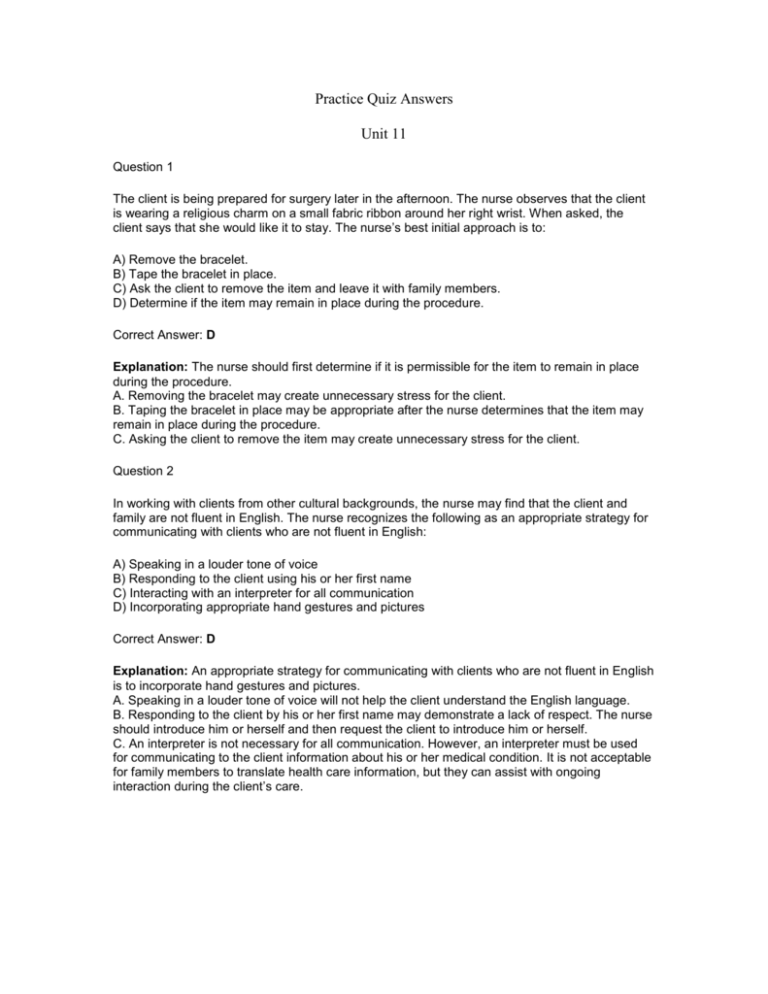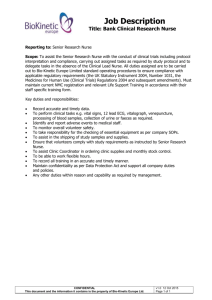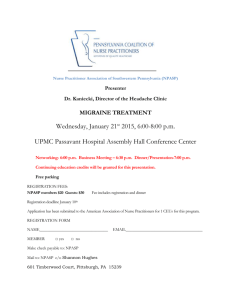Practice Quiz Answers
advertisement

Practice Quiz Answers Unit 11 Question 1 The client is being prepared for surgery later in the afternoon. The nurse observes that the client is wearing a religious charm on a small fabric ribbon around her right wrist. When asked, the client says that she would like it to stay. The nurse’s best initial approach is to: A) Remove the bracelet. B) Tape the bracelet in place. C) Ask the client to remove the item and leave it with family members. D) Determine if the item may remain in place during the procedure. Correct Answer: D Explanation: The nurse should first determine if it is permissible for the item to remain in place during the procedure. A. Removing the bracelet may create unnecessary stress for the client. B. Taping the bracelet in place may be appropriate after the nurse determines that the item may remain in place during the procedure. C. Asking the client to remove the item may create unnecessary stress for the client. Question 2 In working with clients from other cultural backgrounds, the nurse may find that the client and family are not fluent in English. The nurse recognizes the following as an appropriate strategy for communicating with clients who are not fluent in English: A) Speaking in a louder tone of voice B) Responding to the client using his or her first name C) Interacting with an interpreter for all communication D) Incorporating appropriate hand gestures and pictures Correct Answer: D Explanation: An appropriate strategy for communicating with clients who are not fluent in English is to incorporate hand gestures and pictures. A. Speaking in a louder tone of voice will not help the client understand the English language. B. Responding to the client by his or her first name may demonstrate a lack of respect. The nurse should introduce him or herself and then request the client to introduce him or herself. C. An interpreter is not necessary for all communication. However, an interpreter must be used for communicating to the client information about his or her medical condition. It is not acceptable for family members to translate health care information, but they can assist with ongoing interaction during the client’s care. Question 3 Time takes on different meanings from one culture to another. To explore the relation of time to nursing interventions, the nurse should: A) Avoid using set times to do procedures, if possible. B) Maintain a flexible attitude and not become emotionally upset when the client requests procedures to be done at different times. C) Encourage clients to set their own times when they would like the nurse to perform nursing care activities, regardless of the schedule. D) Maintain the set times for treatments and inform the client of the schedule. Correct Answer: B Explanation: Because time takes on different meanings from one culture to another, the nurse should maintain a flexible attitude and not become emotionally upset when the client requests procedures to be done at different times. When making appointments and referrals, anticipated barriers to time adherence should be explored and managed with the client. A. For organizational purposes, nurses should seek clients’ input, and together the nurse and client may set a time to do procedures. C. Although the client’s input should be sought, it is not realistic to have the clients set their own times for nursing care activities regardless of the schedule. Some procedures may be required more frequently than the client would set, or the nurse may be unable to meet the needs of several clients on the unit at the same time. D. Maintaining set times for treatments and informing the client of the schedule does not take into consideration the client’s time orientation. Question 4 The nurse recognizes the terminology that applies to culture and ethnicity. Ethnicity differs from race in that ethnicity: A) Is a unique factor within a cultural group B) Includes more than biologic identification C) Refers to subgroups within a race D) Is the set of conflicting values between races Correct Answer: B Explanation: Ethnicity refers to a shared identity related to social and cultural heritage such as values, language, geographic space, and racial characteristics. Race refers to biologic attributes. A. A variant cultural pattern is a unique factor within a cultural group. C. Subcultures refer to subgroups within a race. D. Ethnocentrism is the root of biases and prejudices comprising beliefs and attitudes associating negative permanent characteristics with people who are perceived to be different from the valued group. Question 5 The nurse’s knowledge about spirituality begins with the nurse: A) Researching all popular religions B) Looking at his or her own beliefs C) Sharing his or her faith with the clients D) Providing prayers and religious articles for clients Correct Answer: B Explanation: Knowledge about spirituality begins with nurses’ insights into their own spirituality. This self-exploration may occur through reading, religious involvement or activities such as meditation to understand their own beliefs and values. A. Researching popular religions may add to the nurse’s knowledge, but knowledge of spirituality begins with the nurse examining his or her own beliefs. It is essential for the nurse to be aware of his or her own beliefs so as not to impose them on others, and to be able to recognize and understand a client’s spiritual needs. C. The nurse’s knowledge about spirituality does not begin with the nurse sharing his or her faith with clients. D. Providing prayers and religious articles for clients may be an intervention to meet a client’s spiritual needs; however, it is not how the nurse’s knowledge about spirituality begins. Question 6 In working with individuals from diverse cultural backgrounds, the nurse attempts to anticipate their particular nutritional needs. For a client who is an Orthodox Jew and maintains a kosher diet, the nurse will make sure that the following is not included in the menu: A) Beef B) Eggs C) Milk D) Pork Correct Answer: D Explanation: Jewish clients who follow a kosher diet will avoid meat from carnivores, pork products, and fish without scales or fins. Therefore, shellfish should not be included in the menu of a client who is an Orthodox Jew and maintains a kosher diet. A. Beef may be included in a kosher diet. B. Eggs may be included in a kosher diet. C. Milk may be included in a kosher diet. Question 7 The nurse recognizes the terminology that applies to culture and ethnicity and its correct application. A client who goes through the process of acculturation will be: A) Identifying with two or more cultures B) Giving up his or her own identity in favor of the dominant culture C) Socializing within his or her primary cultural group D) Adapting to and adopting a new culture Correct Answer: D Explanation: Acculturation is the process of adapting to and adopting a new culture. A. Biculturalism occurs when an individual identifies equally with two or more cultures. B. Assimilation occurs when an individual gives up his or her ethnic identity in favor of the dominant culture. C. Socialization into one’s primary culture as a child is known as enculturation. Question 8 The nurse wants to develop an awareness of the practices of different cultures within the community. One aspect of culture is invisible, or less observable to others. An example of this component of culture is: A) Using cotton garments for clothing B) Wearing an amulet or charm C) Using prayer beads or candles D) Believing in supernatural influences Correct Answer: D Explanation: An example of an invisible (less observable) component of a culture is having a belief in supernatural influences. A. Using cotton undergarments for clothing is a visible (easily seen) component of culture. B. An example of a visible (easily seen) component of culture is the wearing of an amulet or charm. C. An example of a visible (easily seen) component of culture is using prayer beads or candles. Question 9 The nurse may work with clients from many different cultural backgrounds. Nurses, unfortunately and inadvertently, may impose their own cultural beliefs on clients. An example of a cultural imposition on a client is evident in which of the following examples? A) Adaptation of the client’s room to accommodate extra family members who are visiting. B) Seeking information on gender-congruent care for an Egyptian client. C) Holding back more potent pain medication for a client who had a minor procedure. D) Encouraging family to assist with the client’s care. Correct Answer: C Explanation: Holding back more potent pain medication for a client who had a minor procedure is an example of a cultural imposition of the nurse on a client. A. Adaptation of the client’s room to accommodate extra family members is not an example of cultural imposition on a client, but rather is meeting the client’s need by providing culturally congruent care. B. Seeking information on gender-congruent care for an Egyptian client is an example of the desire to provide culturally congruent care. D. Encouraging family to assist with the client’s care is not an example of cultural imposition on a client. Western culture tends to follow a pattern of caring that focuses on self-care and selfdetermination, whereas non-Western cultures typically have care provided by others. Question 10 The nurse believes that a client from another cultural background is using herbal remedies along with the prescribed medication to treat her arthritis. The nurse’s first action should be to: A) Tell the client that herbs will interfere with the prescribed medication. B) Ask the client why additional remedies are being used. C) Determine what herbs are being used and their effectiveness. D) Contact the physician to alert him or her about the herbal remedies. Correct Answer: C Explanation: Rather than dismissing the practice as dangerous and incompatible with Western medicine, practitioners should investigate further whether the practice needs changing. A. The nurse may be making a false statement. Consultation and collaboration with herbalists can prevent unwarranted distress for the client and nurse. B. Asking the client why additional remedies are being used may make the client feel defensive. The nurse must first determine what herbs are being used. D. Contacting the physician is not the first action to be taken by the nurse. The nurse should initially determine what herbs are being used and their effectiveness. 5/10







